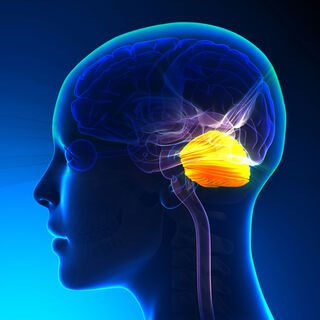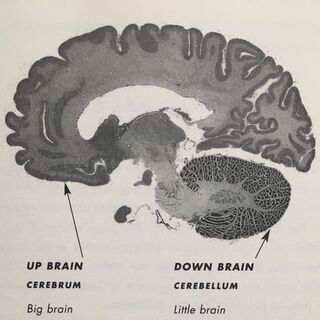Cognition
The Neuroscience of Superfluid Thinking
The cerebellum may coordinate thoughts much like it coordinates fluid movements.
Posted January 30, 2022 Reviewed by Abigail Fagan
Key points
- The cerebral cortex is a thin layer of gray matter covering the cerebrum.
- The cerebellum is tucked beneath the cerebrum and is the seat of "muscle memory." It also coordinates fluid movements.
- Cerebro-cerebellar circuits form a bidirectional communication loop between the cerebrum and the cerebellum.
- Robust cerebro-cerebellar connectivity may coordinate fluid cognition much like it coordinates fluid motion.

Until recently, the human cerebellum was viewed primarily as a brain region that's sole job was to coordinate motor movements; most neuroscientists didn't think the cerebellum facilitated non-motor cognitive functions. But around 1998, at the dawn of the 21st century, this motor-function-only view of the cerebellum started to shift. Today, most neuroscientists agree that our so-called "little brain" plays a big role in cognition.
In this post, I'm going to filter two January 2022 papers that put cerebro-cerebellar functional connectivity in the spotlight through the lens of an "up brain-down brain" model my neuroscientist father and I created in the early 2000s.
The first paper (McAfee, Liu, Sillitoe, & Heck, 2022) presents a new theory of how the cerebellum coordinates neuronal communication in the cerebral cortex. The second paper (Li et al., 2022) examines how cerebro-cerebellar connectivity between microzones of the cerebellum and specific regions of the cerebrum affects verbal fluency during language tasks.
Cerebro-Cerebellar Circuits Coordinate Fluid Motion
In the 1970s, as a rookie tennis player, Arthur Ashe and Björn Borg were my role models.
Borg was notorious for his cool (almost "icy") Swedish temperament and grace under pressure. Ashe was a trailblazer who famously said, "There's a thing in sports called, 'paralysis by analysis.'" My neurosurgeon father, who wrote The Fabric of Mind, filtered their playing styles through brain science.
When coaching me to play like Borg, Dad focused on hacking the vagus nerve by taking a deep diaphragmatic inhalation followed by a long, slow exhale before every serve. This breathing technique activated my parasympathetic nervous system and quelled fight-or-flight stress. When coaching me to play like Ashe, Dad focused on not "overthinking" by unclamping my cerebral cortex and relying on cerebellar muscle memory.

In the mid-2000s, I wrote The Athlete's Way; and my father was the book's medical advisor. From a neuroscience perspective, our goal was to give readers a new split-brain model that would help them optimize flow states, experience superfluidity, and achieve peak performance.
Because the cerebellum has long been known to play a central role in coordinating muscle movements, we hypothesized that athletes could improve the fluidity of their motor coordination by emphasizing the importance of bottom-up processing.
On the flip side, too much top-down cerebral processing would disrupt flow and was likely to cause an overthinking athlete to choke due to "paralysis by analysis."
Notably, the cerebrum ("big brain") has two cerebral hemispheres, and the cerebellum ("little brain") has two cerebellar hemispheres. When coordinating fluid movements, the right cerebellar and left cerebral hemispheres work together to coordinate motor skills on the right side of the body and vice versa.
The criss-cross functional connectivity of "up brain-down brain" is key to creating superfluidity in sports. Interestingly, left-brain thinking also benefits from robust connectivity to the right cerebellar hemisphere, and whole-brain thinking benefits from all four brain hemispheres working in synchrony.
For example, in right-handed people who tend to have most of their language functions seated in the left cerebral hemisphere, microzones in the right cerebellar hemisphere coordinate language tasks (Li et al., 2022). During language tasks involving the left cerebral hemisphere, regions in the right cerebellar hemisphere (e.g., lobule VI, Crus I, and Crus II) are activated as part of a cerebro-cerebellar loop.
Cerebro-Cerebellar Circuits May Coordinate Superfluid Cognitive Processes
As an athlete, my interest in optimizing the functional connectivity of all four brain hemispheres was directly linked to improving my sports performance by facilitating perfectly coordinated frictionless flow (i.e., superfluidity).
As a writer, I realized that anytime I experienced a flow state while touch typing 100+ words per minute using the cerebellar muscle memory I'd laid down in a high school typing class, my thinking also felt superfluid.
Anecdotally, as a retired ultramarathon runner who still loves to jog, I've observed that my creative thinking and writing process benefit from cardio. Fresh ideas seem to bubble up from my subconscious when I'm jogging, and it's much easier to connect the dots between seemingly unrelated ideas while performing moderate-to-vigorous physical activity.
One day, in 2009, as I was walking home from the gym, I bumped into an old friend named Maria, who's a poet, and had also just finished a workout. We started discussing how cardio workouts seemed to improve our ability to craft language. She said, "Poetry pours out of me whenever I'm on the elliptical trainer," while moving her arms and legs in a bipedal motion.
In a flash, as Maria was miming the back and forth motions of being on an elliptical, I visualized a bidirectional feedback loop between all four brain hemispheres creating a cerebro-cerebellar loop that looks like a figure 8. And I imagined how this circuitry might facilitate verbal fluency. I rushed home and drew a rudimentary "Super Eight" brain map (below).

Without explicitly referencing neuroscience, Joyce Carol Oates has vividly described how some prose captures the "fluidity of movement" and how, throughout her writing career, daily jogs have helped her "maintain a consistent, fluid voice" when writing a novel.
In a 1999 piece for the New York Times' arts section, "To Invigorate Literary Minds, Start Moving Literary Feet," Oates elucidates how running expands her consciousness and allows her to "envision what I'm writing as a film or a dream." She goes on to say:
"In running the mind flies with the body; the mysterious efflorescence of language seems to pulse in the brain, in rhythm with our feet and the swinging of our arms. The structural problems I set for myself in writing, in a long, snarled, frustrating, and sometimes despairing morning of work, for instance, I can usually unsnarl by running in the afternoon."
Cerebellar Dysfunction Can Cause Uncoordinated Thinking
Jeremy Schmahmann's Dysmetria of Thought hypothesis posits that a well-functioning cerebellum can coordinate thoughts much like it coordinates movements.
Conversely, a dysfunctioning cerebellum can cause uncoordinated movements or, in some cases, discombobulated thinking. Schmahmann is a neurologist and cerebellar ataxia specialist at Harvard Medical School's Mass. General Hospital. Ataxía means "lack of coordination" in Greek.
In the late 20th century, Schmahmann noticed that some patients with damage to specific microzones of the cerebellum didn't display physical ataxias but seemed to have trouble coordinating their thoughts.
In 1998, Schmahmann coined the term "dysmetria of thought." The same year, he published a landmark paper describing cerebellar cognitive affective syndrome (CCAS). At the time, it was a radical notion to speculate that the cerebellum was involved in non-motor functions such as cognition.
Flash forward to 2022. We now have increasing evidence that the cerebellum plays a significant role in coordinating cognitive processes.

In their January 2022 open-access paper, "Cerebellar Coordination of Neuronal Communication in Cerebral Cortex," first author Samuel McAfee et al. explain how the cerebellum coordinates and optimizes cerebral cortical communication during cognitive processes much like it optimizes motor coordination. Their Figure 1 illustration (above) shows these cerebro-cerebellar functions in action.
Moving forward, we need more research to better understand how cerebro-cerebellar connectivity coordinates fluid thinking.
References
Yanyan Li, Lihao Yang, Lihua Li, Yuanjun Xi, Peng Fang. "The Resting-State Cerebro-Cerebellar Function Connectivity and Associations With Verbal Working Memory Performance." Behavioural Brain Research (First published: January 24, 2022) DOI: 10.1016/j.bbr.2021.113586
Samuel S. McAfee, Yu Liu, Roy V. Sillitoe, and Detlef H. Heck. "Cerebellar Coordination of Neuronal Communication in Cerebral Cortex." Frontiers in Systems Neuroscience (First published: January 11, 2022) DOI: 10.3389/fnsys.2021.781527
Jeremy D. Schmahmann. "Dysmetria of Thought: Clinical Consequences of Cerebellar Dysfunction on Cognition and Affect." Trends in Cognitive Sciences (First published: September 01, 1998) DOI: 10.1016/S1364-6613(98)01218-2
Jeremy D. Schmahmann and Janet C. Sherman. "The Cerebellar Cognitive Affective Syndrome." Brain: A Journal of Neurology (First published: April 01, 1998) DOI: 10.1093/brain/121.4.561




